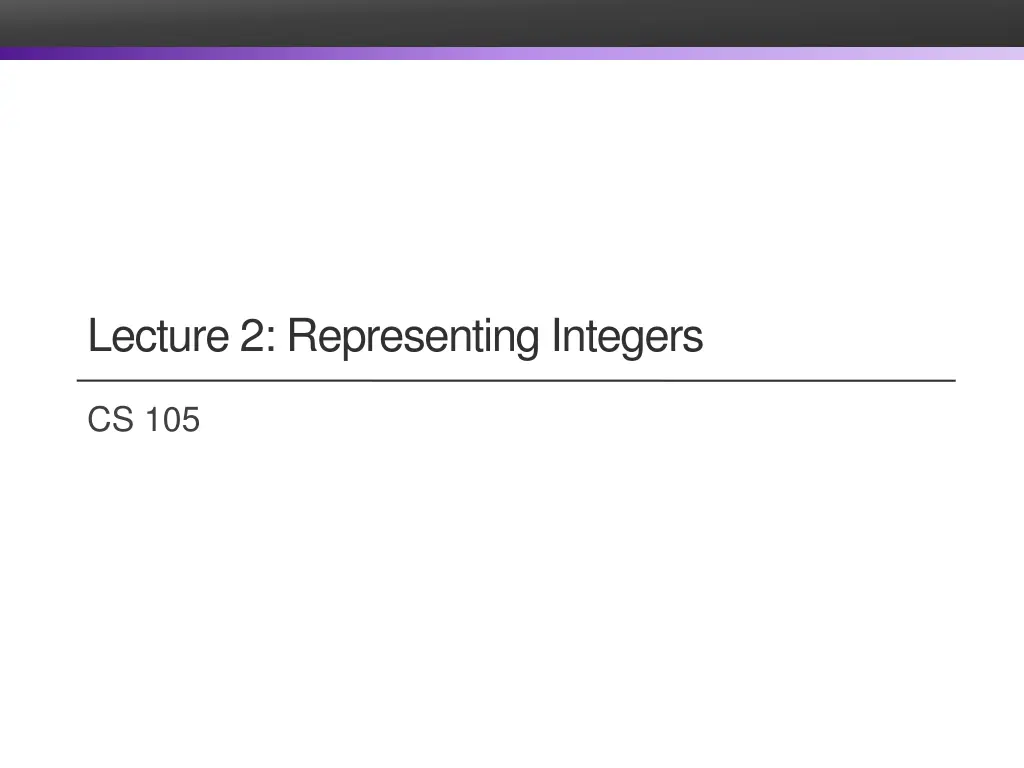
Understanding Integer Representation and Memory Storage
Dive into the world of representing integers using various numeral systems and explore how bits are stored in different memory devices such as SRAM, DRAM, magnetic disks, optical disks, and flash disks.
Download Presentation

Please find below an Image/Link to download the presentation.
The content on the website is provided AS IS for your information and personal use only. It may not be sold, licensed, or shared on other websites without obtaining consent from the author. If you encounter any issues during the download, it is possible that the publisher has removed the file from their server.
You are allowed to download the files provided on this website for personal or commercial use, subject to the condition that they are used lawfully. All files are the property of their respective owners.
The content on the website is provided AS IS for your information and personal use only. It may not be sold, licensed, or shared on other websites without obtaining consent from the author.
E N D
Presentation Transcript
Review: Memory bytes Memory is an array of bits 1 1 1 0 00110111 1 A byte is a unit of eight bits 1 0 0 3 1 0 0 0 An index into the array is an address, location, or pointer Often expressed in hexadecimal 11010001 1 0 1 1 2 1 1 0 0 We speak of the value in memory at an address The value may be a single byte or a multi-byte quantity starting at that address 01010011 1 0 1 0 1 0 0 1 1 01101100 0 1 1 0 0
Review: Bits Require Interpretation 10001100 00001100 10101100 00000000 might be interpreted as The integer 3,485,745 A floating point number close to 4.884569 x 10-39 The string 105 A portion of an image or video An address in memory
Representing Integers Arabic Numerals: 47 Roman Numerals: XLVII Brahmi Numerals: Tally Marks: IIII IIII IIII IIII IIII IIII IIII IIII IIII II
Base-10 Integers 1000 (103) 100 (102) 10 (101) 1 (100) 0 0 0 5 0 0 4 7 1 8 8 7
Storing bits Static random access memory (SRAM): stores each bit of data in a flip-flop, a circuit with two stable states Dynamic Memory (DRAM): stores each bit of data in a capacitor, which stores energy in an electric field (or not) Magnetic Disk: regions of the platter are magnetized with either N-S polarity or S-N polarity Optical Disk: stores bits as tiny indentations (pits) or not (lands) that reflect light differently Flash Disk: electrons are stored in one of two gates separated by oxide layers
Base-2 Integers (aka Binary Numbers) 128 (27) 64 (26) 32 (25) 16 (24) 8 (23) 4 (22) 2 (21) 1 (20) 0 0 0 0 0 1 0 1 0 0 1 0 1 1 1 1 1 1 1 1 1 1 1 1
Binary Numbers Decimal (Base-10): 1011 = 1 103+ 0 102+ 1 101+ 1 100 = 1011 Binary (Base-2): 1011 = 1 23+ 0 22+ 1 21+ 1 20 = 11
Exercise 1: Binary Numbers Consider the following four-bit binary values. What is the (base-10) integer interpretation of these values? 1. 0001 2. 1010 3. 0111 4. 1111
Exercise 2: Binary Number Range What are the max number and min number that can be represented by a w-bit binary number? w = 3 1. w = 4 2. w = 8 3.
Unsigned Integers in C C Data Type Size (bytes) unsigned char 1 unsigned short 2 unsigned int 4 unsigned long 8
ASCII characters Char Dec Binary Char Dec Binary Char Dec Binary Char Dec Binary Char Dec Binary 1 49 00110001 A 65 01000001 Q 81 01010001 a 97 01100001 ! 33 00100001 2 50 00110010 B 66 01000010 R 82 01010010 b 98 01100010 " 34 00100010 3 51 00110011 C 67 01000011 S 83 01010011 c 99 01100011 # 35 00100011 4 52 00110100 D 68 01000100 T 84 01010100 d 100 01100100 $ 36 00100100 5 53 00110101 E 69 01000101 U 85 01010101 e 101 01100101 % 37 00100101 6 54 00110110 F 70 01000110 V 86 01010110 f 102 01100110 & 38 00100110 7 55 00110111 G 71 01000111 W 87 01010111 g 103 01100111 ' 39 00100111 8 56 00111000 H 72 01001000 X 88 01011000 h 104 01101000 ( 40 00101000 9 57 00111001 I 73 01001001 Y 89 01011001 i 105 01101001 ) 41 00101001 : 58 00111010 J 74 01001010 Z 90 01011010 j 106 01101010 * 42 00101010 ; 59 00111011 K 75 01001011 [ 91 01011011 k 107 01101011 + 43 00101011 < 60 00111100 L 76 01001100 \ 92 01011100 l 108 01101100 , 44 00101100 = 61 00111101 M 77 01001101 ] 93 01011101 m 109 01101101 - 45 00101101 > 62 00111110 N 78 01001110 ^ 94 01011110 n 110 01101110 . 46 00101110 ? 63 00111111 O 79 01001111 _ 95 01011111 o 111 01101111 / 47 00101111 @ 64 01000000 P 80 01010000 ` 96 01100000 p 112 01110000 0 48 00110000
Hexidecimal Numbers 00101100 00110101 00110000 11100001 Dec Hex 0 0 1 1 2 c 3 5 3 0 e 1 2 2 3 3 4 4 0x2c3530e1 5 5 6 6 7 7 8 8 9 9 10 a 11 b 12 c 13 d 14 e 15 f
Exercise 3: Hexidecimal Numbers Consider the following hexidecimal values. What is the representation of each value in (1) binary and (2) decimal? 1. 0x0a 2. 0x11 3. 0x2f
Endianness 47 vs 74
Endianness Big Endian: low-order bits go on the right (47) I tend to think in big endian numbers, so examples in class will generally use this representation Networks generally use big endian (aka network byte order) Little Endian: low-order bits go on the left (74) Most modern machines use this representation I will try to always be clear about whether I'm using a big endian or little endian representation When in doubt, ask!
Arithmetic Logic Unit (ALU) circuit that performs bitwise operations and arithmetic on integer binary types
Bitwise vs Logical Operations in C Bitwise Operators &, |, ~, ^ View arguments as bit vectors operations applied bit-wise in parallel Logical Operators &&, ||, ! View 0 as False View anything nonzero as True Always return 0 or 1 Early termination Shift operators <<, >> Left shift fills with zeros For unsigned integers, right shift is logical (fills with zeros)
Exercise 4: Bitwise vs Logical Operations Assume unsigned char data type (one byte). What do each of the following expressions evaluate to (interpreted as unsigned integers and expressed base-10)? 1. ~226 2. !226 3. 120 & 85 4. 120 | 85 5. 120 && 85 6. 120 || 85 7. 81 << 2 8. 81 >> 2
Example: Using Bitwise Operations x & 1 (x + 7) & 0xFFFFFFF8 x << 2 x is odd round up to a multiple of 8 "multiply by 4"
Addition Example Compute 5 + 6 assuming all ints are stored as eight-bit (1 byte) unsigned values 1 1 0 0 0 0 0 1 0 1 0 0 0 0 0 1 0 1 + 0 0 0 0 0 1 1 0 + 0 0 0 0 0 1 1 0 0 0 0 0 0 0 0 0 1 1 0 0 1 1 1 1 = 11 (Base-10) Like you learned in grade school, only binary! and with a finite number of digits
Addition Example with Overflow Compute 200 + 100 assuming all ints are stored as eight- bit (1 byte) unsigned values 1 1 1 1 1 1 0 0 1 0 0 0 1 1 0 0 1 0 0 0 + 0 1 1 0 0 1 0 0 + 0 1 1 0 0 1 0 0 0 0 1 1 0 0 0 0 0 0 1 1 1 1 0 0 = 44 (Base-10) Like you learned in grade school, only binary! and with a finite number of digits
Error Cases Assume ?-bit unsigned values 2? 2 2? 0 [ ) representable values [ ) Possible values of ? + ? ?? = ? + ? (normal) ? +? ? + ? 2? (overflow) overflow has occurred iff ? +? ?? < ?
Exercise 5: Binary Addition Given the following 5-bit unsigned values, compute their sum and indicate whether or not an overflow occurred x y x+y overflow? 00010 01100 10100 00101 00100 10001
Multiplication Example Compute 5 x 6 assuming all ints are stored as eight-bit (1 byte) unsigned values 0 0 0 0 0 1 0 1 0 0 0 0 0 1 0 1 x 0 0 0 0 0 1 1 0 x 0 0 0 0 0 1 1 0 0 0 0 0 0 0 0 0 0 0 0 0 0 0 0 0 0 0 0 0 0 1 0 1 0 0 0 0 0 1 0 1 0 0 + _ + _ 0 0 0 0 0 1 0 1 0 0 0 0 0 1 0 1 0 0 0 0 0 1 1 1 1 0 0 0 0 1 1 1 1 0 0 0 = 30 (Base-10) Like you learned in grade school, only binary! and with a finite number of digits
Multiplication Example Compute 200 x 3 assuming all ints are stored as eight-bit (1 byte) unsigned values 1 1 0 0 1 0 0 0 1 1 0 0 1 0 0 0 x 0 0 0 0 0 0 1 1 x 0 0 0 0 0 0 1 1 1 1 0 0 1 0 0 0 1 1 0 0 1 0 0 0 + _ + _ 1 1 0 0 1 0 0 0 1 1 0 0 1 0 0 0 0 0 0 1 0 1 1 0 0 0 0 1 0 1 1 0 0 0 1 0 1 0 = 88 (Base-10) Like you learned in grade school, only binary! and with a finite number of digits
Error Cases Assume ?-bit unsigned values 2? 2? 2? 0 [ ) representable values [ ) Possible values of ? ? ?? = ? ? mod 2? ? ?
Exercise 6: Binary Multiplication Given the following 3-bit unsigned values, compute their product and indicate whether or not an overflow occurred x y x*y overflow? 100 010 111 101 011 010
Multiplying with Shifts Multiplication is slow Bit shifting is kind of like multiplication, and is often faster x * 8 = x << 3 x * 10 = x << 3 + x << 1 Most compilers will automatically replace multiplications with shifts where possible


